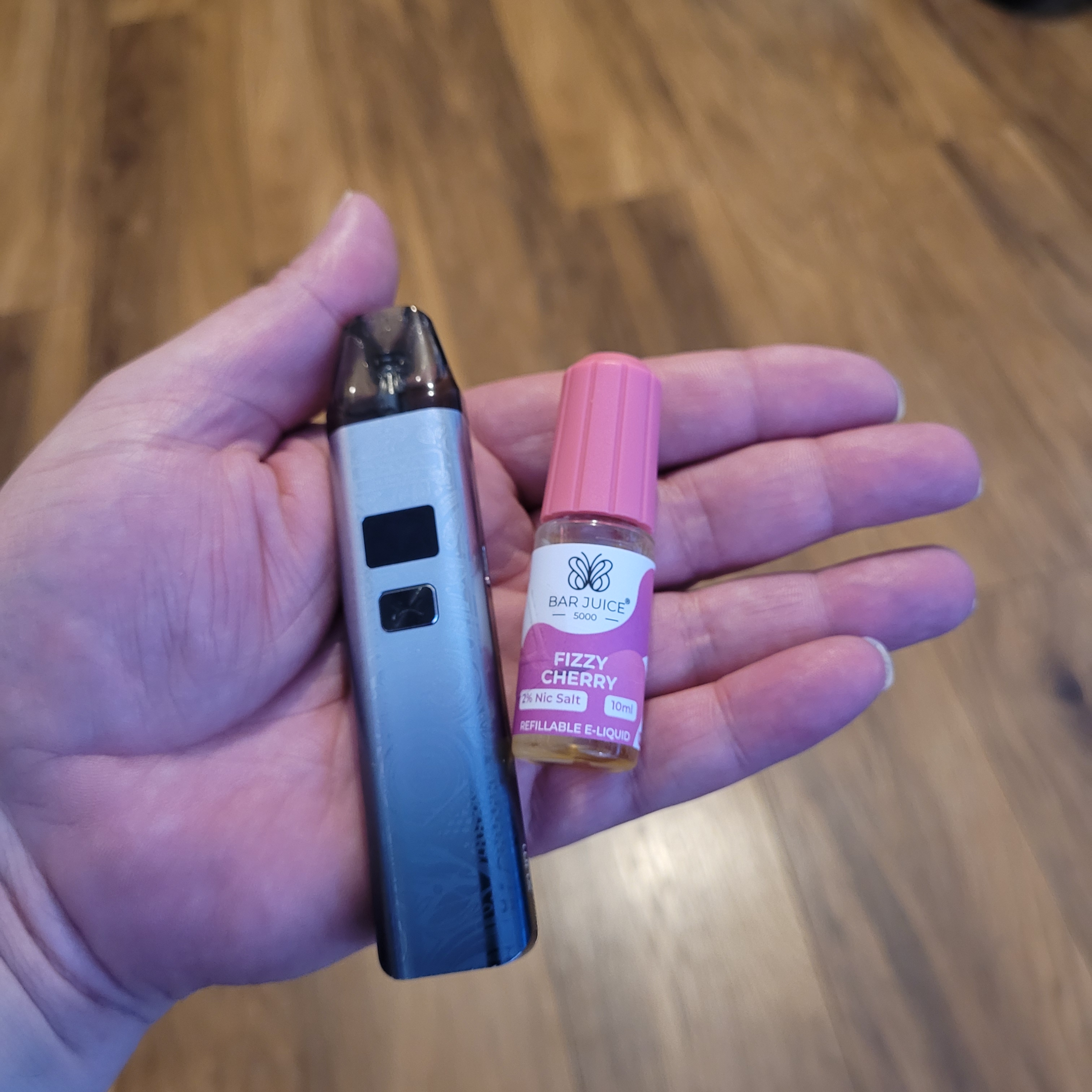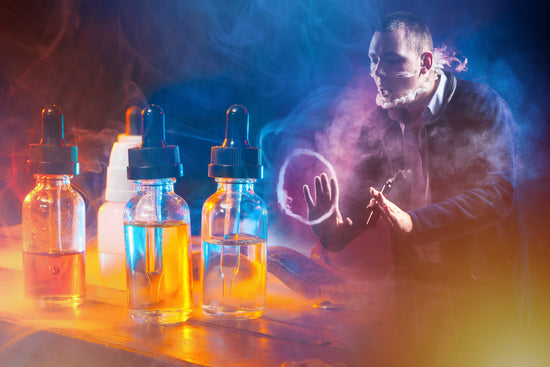Why Do I Cough When I Vape?
It's a common question among new and experienced vapers alike: "Why do I cough when I vape?" It might be unsettling, especially for those who've taken up vaping as a means to quit smoking. But rest assured, it is a normal part of the vaping journey for some individuals and there are ways to manage it. In this post, we'll explore the causes of a vaping cough and offer strategies to prevent it.
Is It Normal to Cough from Vaping?
Yes, it is entirely normal for some people to cough when they vape, especially in the beginning. This cough, sometimes referred to as a vaper's cough, is particularly common among new vapers making the transition from smoking. Vaping and smoking may seem similar, but the sensation and the substances you're inhaling are different, and your respiratory system may need time to adjust.
Understanding the Vaping Cough
A few reasons can explain why you might cough when you vape. First, we need to understand that vaping involves inhaling vapour produced by heating an e-liquid or vape juice in your vaping device, be it a vape pen, a vape mod, or any other type of e-cigarette. The e liquid contains nicotine and a mix of propylene glycol (PG) and vegetable glycerine (VG), among other ingredients.
The propylene glycol in e-liquids can sometimes cause throat irritation, leading to a sore throat and persistent cough (vapers cough). This is because PG is a humectant, meaning it absorbs moisture and can result in a dry, sore throat, especially when vaping too much or chain vaping. Furthermore, the inhalation technique used for vaping can also trigger a cough. This is one of the vaping side effects that can be managed with proper vaping technique.
Vaping Technique Matters

If you've recently made the switch from smoking cigarettes to vaping, it might take some time to adapt to the new inhale technique. Unlike smoking where you draw smoke directly into your lungs, vaping often involves a two-step process, particularly with mouth-to-lung (MTL) devices. You first draw the vapour into your mouth and then inhale it into your lungs. This method is similar to smoking a traditional cigarette and provides a realistic smoking sensation.
Incorrect inhalation could cause you to cough as your throat gets hit with too much vapour at once. If you're using a sub-ohm device, they will produce more vapor, which might cause slight irritation or a sore throat from vaping, especially if you're not used to it.
E-Liquid Factors
Your e-liquid's nicotine strength plays a vital role in whether or not you experience a cough while vaping. Higher nicotine levels in your vape juice can provide a strong "throat hit," which might feel harsh and induce coughing, especially for new vapers. Nicotine salts, or nic salts, are a form of nicotine that provide a smoother throat hit and could be a suitable alternative for those sensitive to traditional, freebase nicotine.
The ratio of propylene glycol (PG) to vegetable glycerine (VG) in your e-liquid can also contribute to vaping-induced coughing. As we mentioned earlier, propylene glycol can cause a dry throat and coughing. E-liquids with a higher VG to PG ratio produce denser, smoother vapour that might be gentler on the throat.
Remember to stay hydrated. Vaping, particularly propylene glycol, can cause mild dehydration, which might exacerbate a sore throat and coughing.
How do you get rid of a vaper's cough?
You're probably asking yourself now, "How can I stop coughing when vaping?" Good news - there are ways to manage and even eliminate a vaper's cough. Let's delve into some potential solutions.
Adjust THE WAY YOU VAPE
First and foremost, try to adjust your vaping technique. As a vaper, especially if you're a new vaper, it's essential to learn proper inhalation methods. You might be tempted to inhale deeply and quickly, like smoking a cigarette, but this can result in a cough.
Instead, try taking smaller, more gentle puffs. Start by drawing the vapour into your mouth before inhaling into your lungs. This mouth-to-lung technique is commonly used with vape pens and lower-power vaping devices. If you're using a device that produces a significant amount of vapour, like a high-powered vape mod, try an MTL device instead.
Hydrate
It may sound simple, but staying hydrated is an effective way to combat a vaping-induced cough. As we mentioned before, propylene glycol (PG) in your e-liquid can cause dry mouth and throat, which can lead to coughing. So, ensure you drink plenty of water throughout the day, particularly when you're vaping.
Adjust Nicotine Levels
The nicotine strength in your e-liquid could be causing you to cough. If you've chosen a high nicotine level to mimic the strength of the cigarettes you used to smoke, you may want to consider reducing it. Lower nicotine content often result in a less harsh throat hit, which may help prevent coughing. You could also consider switching to nicotine salts for a smoother experience.
Experiment with Different E-Liquids
Consider experimenting with e-liquids that have a higher VG (vegetable glycerine) to PG (propylene glycol) ratio. VG tends to produce smoother vapour, which can be less irritating to the throat. You can find a range of e-liquids with different VG/PG ratios, allowing you to find one that works best for you.
Choose the Right Vaping Device
Not all vape kits are created equal. Some produce more vapour than others, and for a beginner, this might lead to coughing. If you're new to vaping, consider starting with a simple vape pen or pod system. These types of devices often provide a mouth-to-lung vaping style that's more similar to smoking a cigarette.
Moreover, the type of vape kit you use can make a difference. Certain vaping devices come with adjustable power settings. Starting your vape out on a low power setting and gradually increasing it can help your throat get used to the vapour and may reduce coughing.
On the Path to an Enjoyable Vaping Experience

Switching from smoking to vaping is a significant change, and it's normal to encounter some challenges along the way. Experiencing a vaping cough is one such challenge, but as we've seen, there are numerous strategies to manage and overcome it. By tailoring your inhale technique, adjusting your e-liquid, and choosing the right vaping device, you can make your vaping journey more enjoyable.
Vaping is a personal experience, and what works for one person may not work for another. So, don't be afraid to experiment and find what makes vaping most enjoyable for you. Remember, the goal is to quit smoking, and each person's journey towards that goal is unique.
Coughing when vaping should lessen over time as your body adjusts to the change. However, if you find your cough persisting or causing significant discomfort, it's always wise to consult with a healthcare professional.
Beyond Coughing: Other Considerations
As you journey through vaping, remember to listen to your body. Just as some individuals cough when vaping, you might experience other reactions. Mild side effects from vaping include a sore throat or slight irritation, especially when you start vaping or if you're vaping too much. If you notice these symptoms, don't panic. Simply apply the same troubleshooting methods you've learned to manage your vaping cough.
That said, understanding the impact of vaping on your lungs is critical, especially for long-term smokers. The question often arises, "how long does it take for your lungs to heal from vaping?" The answer is not straightforward as it varies from person to person and depends on factors like the duration and intensity of smoking, overall health, lung disease, and lifestyle habits. However, experts agree that reducing exposure to tobacco smoke is beneficial for lung health.
Understanding the Ingredients in Your Vape Juice
Awareness of what's in your vape juice is crucial to ensure a pleasant vaping experience. E liquids generally contain propylene glycol (PG), vegetable glycerine (VG), nicotine, and flavorings. Both PG and VG are considered safe for oral consumption, but their effects when inhaled over the long term are not entirely understood.
Propylene glycol and vegetable glycerine serve as the base for your vape juice. Propylene glycol (PG) is thinner and provides a more robust "throat hit," mimicking the sensation of smoking. It can, however, cause a dry throat and mouth, leading to a vaping cough. On the other hand, vegetable glycerine (VG) is thicker and produces denser vapour, providing a smoother vaping experience.
Knowing Your Vaping Device

The vaping device you choose plays a crucial role in your vaping experience. There is a vast range of vape kits available in the market, from simple e-cigarettes or vape pens to advanced vape mods. Understanding the differences can help you make an informed decision and choose a device that suits your preferences.
For instance, disposable vapes and MTL kits often mimic the experience of smoking a cigarette, offering a mouth-to-lung inhalation technique. They are easy to use and ideal for beginners. In contrast, vape mods and high-powered devices provide a direct lung vaping experience, producing more vapour and flavour but require more expertise to operate safely.
Conclusion
Vaping can be a helpful tool in the journey to quit smoking. And while the transition may come with its challenges like a vaping cough, these issues are generally manageable. Remember to take it slow and adjust the way you vape, e-liquid, and vaping device as needed to create a more enjoyable vaping experience. It's all part of the journey to a smoke-free life.
Stay informed and proactive about your vaping habits. Understanding why you cough when you vape and how to manage it will ensure your vaping journey remains smooth and satisfying. Remember, vaping is personal, and what works best for you may not work for someone else. With a little patience, experimentation, and knowledge, you'll find what makes your vaping experience most enjoyable.
As always, if you have persistent health concerns related to vaping, don't hesitate to consult with a healthcare professional. Your health should always be your top priority. Happy vaping!
FAQ Roundup
Q1: Why do I cough when I vape? A1: Coughing when vaping can occur for a few reasons including a reaction to propylene glycol, the nicotine strength in your e-liquid, or the vaping technique you're using. It's also not uncommon for new vapers, especially those transitioning from smoking, to cough initially as their body adjusts.
Q2: Is it normal to cough from vaping?
A2: Yes, especially if you're new to vaping or have recently quit smoking. Your body is adjusting to the change from inhaling tobacco smoke to inhaling e-liquid vapour. This transition may cause some initial discomfort such as coughing, but this typically subsides over time.
Q3: How do you get rid of a vaper's cough?
A3: There are several strategies you can use. You might need to adjust your vaping technique, change your e-liquid, lower your nicotine level, stay hydrated, or choose a different vaping device. It's also essential to give your body time to adjust, especially if you've recently quit smoking.
Q4: Can I prevent coughing when vaping?
A4: You can certainly manage and possibly prevent coughing by modifying your vaping habits. Choosing the right nicotine strength, adjusting your inhalation technique, and maintaining adequate hydration can all help prevent a vaping-induced cough.
Q5: Is vaping safer than smoking?
A5: While vaping is not risk-free, Public Health England maintains that vaping is significantly less harmful than smoking. Remember, the goal of vaping is often to help people quit smoking, but if you don't smoke cigarettes, it's advisable not to start vaping.
Q6: Will vaping damage my lungs?
A6: Research is ongoing about the long-term effects of vaping on the lungs. However, many experts agree that vaping is less harmful than smoking, which is known to cause severe lung diseases. If you have concerns about your lung health while vaping, consult with a healthcare professional.
Q7: How long does it take for your lungs to heal from vaping?
A7: The time it takes for lungs to heal from vaping can vary greatly depending on various factors such as the length and intensity of previous smoking habits, overall health status, and lifestyle habits. Quitting smoking is the first step towards improving lung health.
Q8: What is "vaper's tongue"?
A8: "Vaper's tongue" is a term used in the vaping community to describe a condition where vapers temporarily lose the ability to taste vape juice. This is typically due to vaping the same flavour repeatedly and your taste buds becoming desensitized, but can also be caused by dehydration and certain medications.
Q9: What is the difference between freebase nicotine and nicotine salts?
A9: Freebase nicotine, commonly found in e-liquids, is a form of nicotine that is considered pure because it hasn't been altered by any chemicals. On the other hand, nicotine salts are formed by combining nicotine (in its freebase state) with one or more types of acids. Nicotine salts often provide a smoother vaping experience, especially at higher nicotine levels.
Q10: How can I choose the right vape juice?
A10: Choosing the right vape juice depends on several factors such as your preferred nicotine strength, whether you prefer freebase nicotine or nicotine salts, and your preferred flavours. Additionally, consider the PG/VG ratio: a higher VG content tends to produce more vapour and a smoother hit, while a higher PG content delivers a stronger throat hit. Experimenting with different e-liquids can help you find what works best for you.







